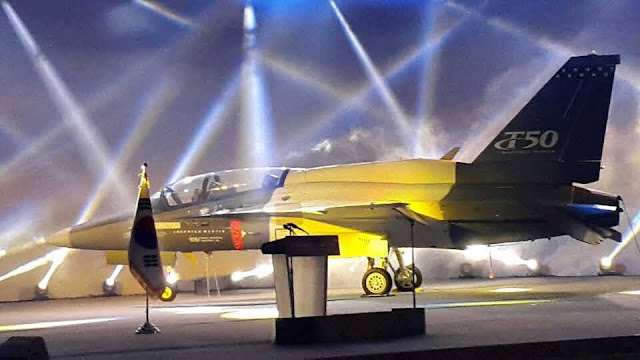Korean Aerospace Industries and Lockheed Martin rolled out the first prototype trainer jet to be offered for U.S. Air Force T-X next g...
Korean Aerospace Industries and Lockheed Martin rolled out the first prototype trainer jet to be offered for U.S. Air Force T-X next generation trainer competition.
The demonstrator is based on the T-50 trainer/light-attack aircraft developed by KAI for South Korean armed forces, with assistance from Lockheed Martin.
The most striking structural difference from the T-50 trainer is the dorsal hump. Major features include cockpit with large area display, embedded training system and aerial refueling capability.
KAI says ground test and first flight are targeted in 2016. The aircraft is powered by the same GE F404 afterburning turbofan engine with dual channel FADEC system.
The USAF T-X program aims to replace the ageing fleet of 431 Northrop Grumman T-38 Talon trainers, which have been serving since the 1960s. The requirement is estimated for 350 aircraft.
The T-38 which was built in 1961 is inadequate to prepare pilots for the advanced fifth generation aircraft like the F-35. Even though the T-38 has been upgraded with a glass cockpit, the inability to upgrade the T-38’s performance and simulated sensor capability hampered teaching critical skills essential to today’s military pilots.
A second issue with the T-38 was aircraft sustainment. The T-38s have not met training command’s requirement for 75-percent availability since 2011, meaning many are not mission capable and unavailable for training.
Currently, 12 of 18 advanced pilot training tasks can’t be completed with the T-38, relying on fighter and bomber formal training units to complete the training at a much greater cost.
 |
| KAI Photo |
The T-X requirements identify three key performance characteristics for the advanced pilot training mission: sustained G, simulator visual acuity and performance, and aircraft sustainment. A highlight in the requirements is embedded training with synthetic sensors and data link.
Other competitors for the program include the Northrop Grumman, Boeing-Saab team -both offering a clean sheet design and the Italian Alenia Aermacchi offering the T-100 based on its M-346 lead in fighter/trainer aircraft.
Lockheed Martin had earlier revealed a backup clean sheet design for the T-X competition, developed by its famous Skunk Works division in-case USAF opts for a bespoke system.











